Growing your own fresh lettuce is possible even without a big plot of land for a garden.
In fact, lettuce is arguably the best crop to choose when you’re using alternative growing methods such as container gardening, particularly for novice growers who want to experiment before moving on to crops that require more intensive caretaking.
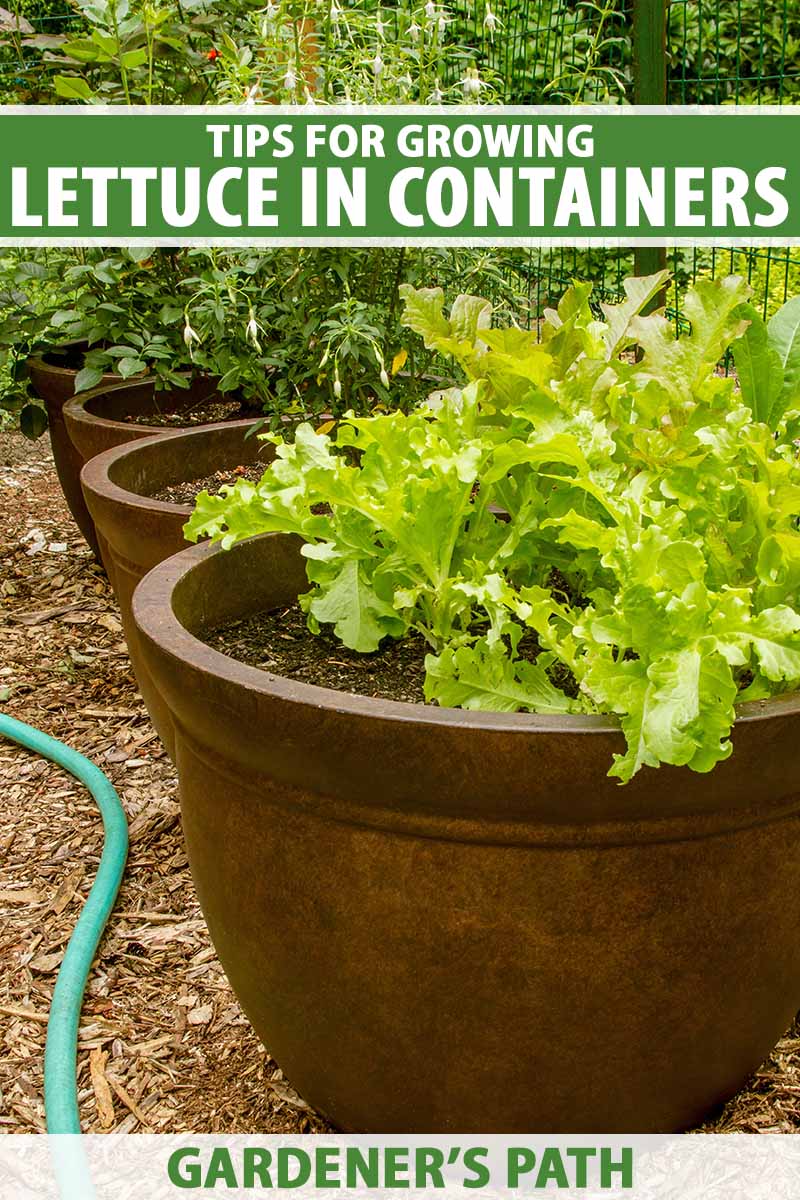
We link to vendors to help you find relevant products. If you buy from one of our links, we may earn a commission.
Those versatile, leafy heads spring up quickly, grow fast, and leave little work to be done when a container garden is properly planned – which it will be, since you’re taking the time to learn just how to do it. Good thinking!
After doing a bit of research into the many different varieties of lettuce available on the market and making a selection, it’s just a matter of choosing appropriate containers and potting soil, finding a location, and creating a schedule for caretaking that gets the job done.
We’ll cover these important points and more, up ahead. Here’s everything you’ll find as you read on:
What You’ll Learn
Benefits of Growing Lettuce in Containers
Containers open up new possibilities for gardeners who want to grow their own food, even if they have some limitations that make conventional gardening difficult.
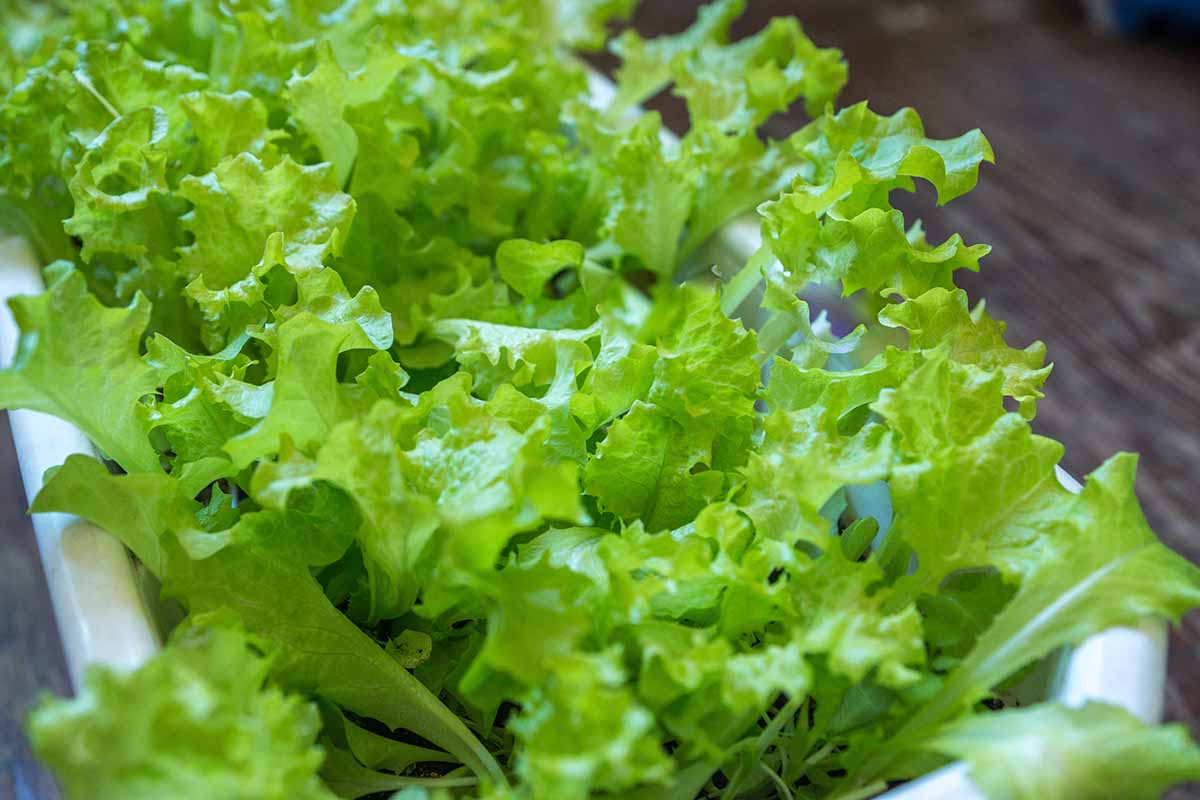
Whether those limitations are logistical, such as a lack of space or little time to dedicate to the project, or they’re related to physical needs, they can often be overcome. So many customizable alternatives exist.
For those of us who live in regions where the climate is harsh and unfriendly to delicate foliage, like mine here in Florida, having the convenience of mobility is a game changer.
When the scorching sun is sweltering overhead and lettuce would normally wither or bolt, the fragile heads can be relocated, pot and all, to a cooler, shadier spot.
When outdoor temperatures drop too low for comfort, bringing the garden indoors where it can safely soak up the sun in front of a kitchen window is another bonus.
We can’t control the weather, but we can find ways to circumvent it.
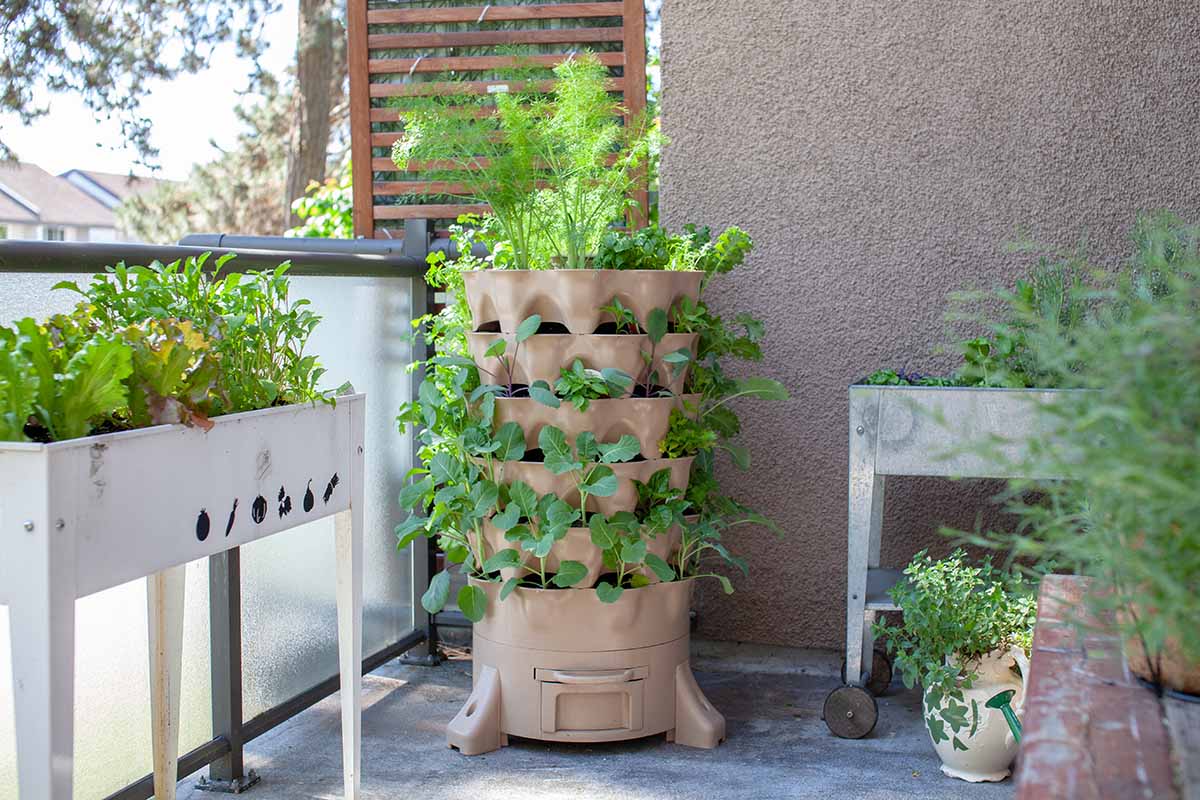
If you’re really short on space but you really enjoy fresh vegetables, some vessels can be stacked on a frame, or you might opt for a grow tower instead.
These vertical options can increase planting space exponentially and can often be reused many times. We’ll discuss those a bit more up ahead.
Pest problems, which are very common with leafy greens, can also be alleviated by hanging, relocating, or covering a container garden.
Limiting access for uninvited critters is the best prevention for the damage they can cause.
Poor soil or low rainfall may be a hindrance to producing healthy plants, but small, manageable containers full of rich soil solve these issues as well.
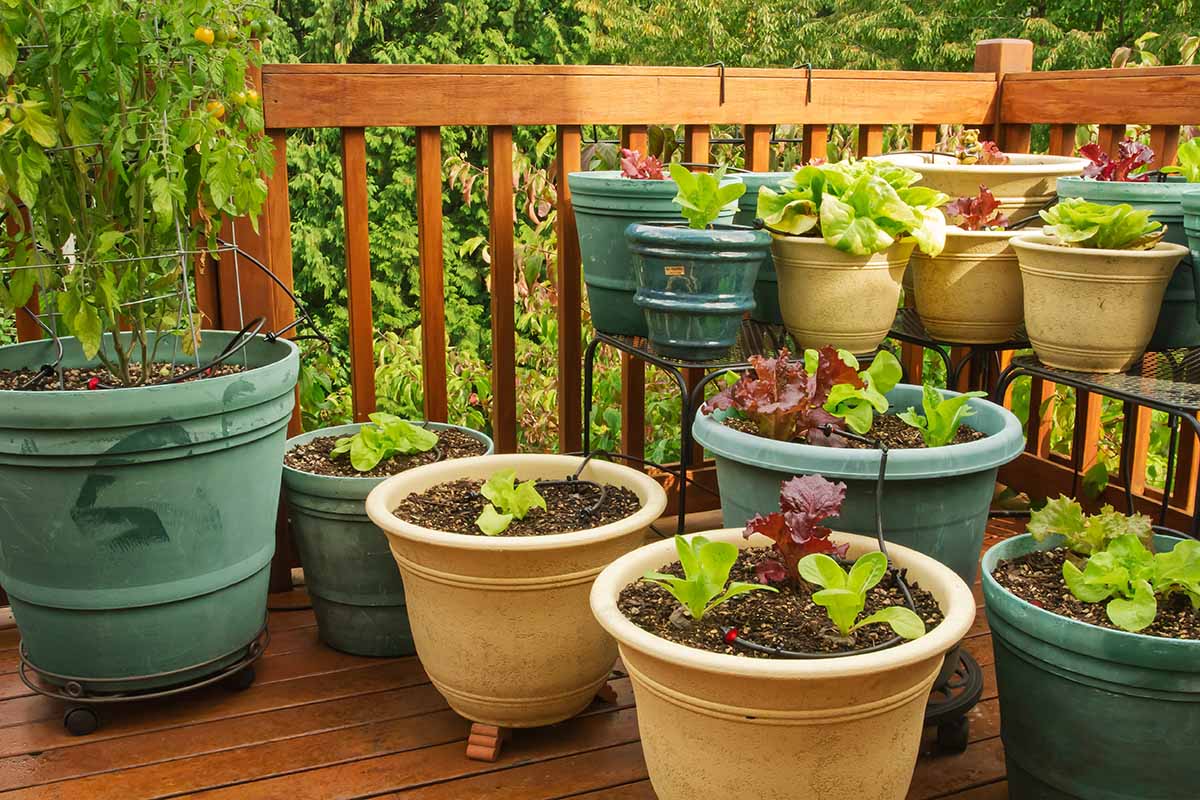
Just bear in mind that the smaller volume of soil may require more frequent watering if vessels aren’t receiving regular rainfall.
All of these perks and more amount to an easier, more flexible experience than that of in-ground growing. But it’s important to choose the right container or some of those perks can become liabilities.
So, what do we look for in a planting vessel? Let’s go over that next.
Choosing a Container
All types of cultivated lettuce have a relatively small, shallow root system.
Because these plants have a short lifespan and don’t grow very large, they don’t need to reach too far or deeply for water and nutrients.
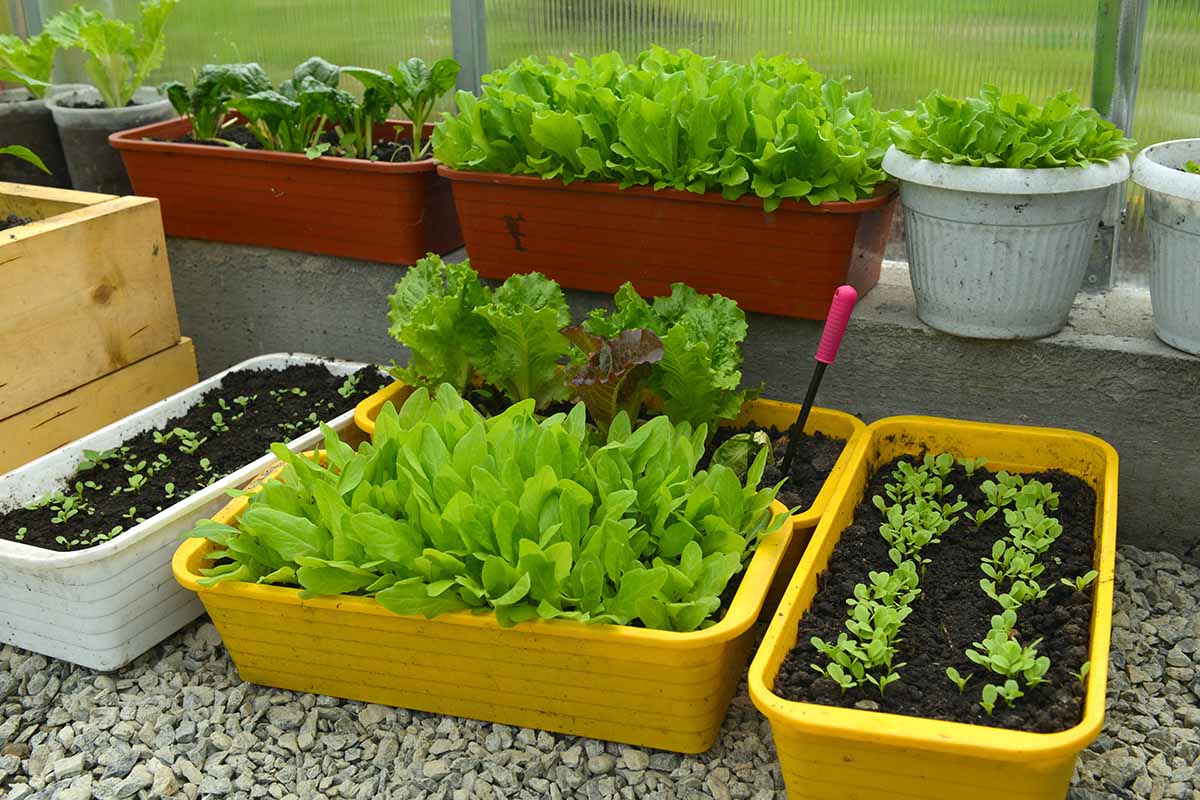
This is beneficial since you won’t need huge planters to accommodate massive roots and other underground structures like you would if you were growing potatoes, for example.
Six to eight inches of depth and about the same width is all the space needed to produce one or two lettuce plants, depending on the variety and its mature size.
A wide-mouth container is better to allow more room for spread, especially if several plants will be grouped together or if the mature size is on the larger side.
Unglazed ceramic vessels perform better because the porous material allows air to transpire, aerating the soil within, reducing the likelihood of overwatering, and sometimes, limiting the spread of pathogens that can damage the roots.
If you know that you’re a bit heavy-handed with watering, then unglazed ceramic is definitely your best bet.
This low bowl-shaped ceramic planter with notched detailing from Terrain is a good choice for growing lettuce indoors.
Notched Ceramic Low Bowl Planter
Measuring five inches tall and 12 inches in diameter, it has a wide profile which is perfect for leaf varieties or for growing one to two smaller heads.
Plastic, resin, or other materials can also be used, but may require a bit more attention so they don’t hold water that can cause mold or mildew to grow, or harbor pathogens that lead to root rot.
Be sure to avoid overwatering and check to make sure they have adequate drainage.
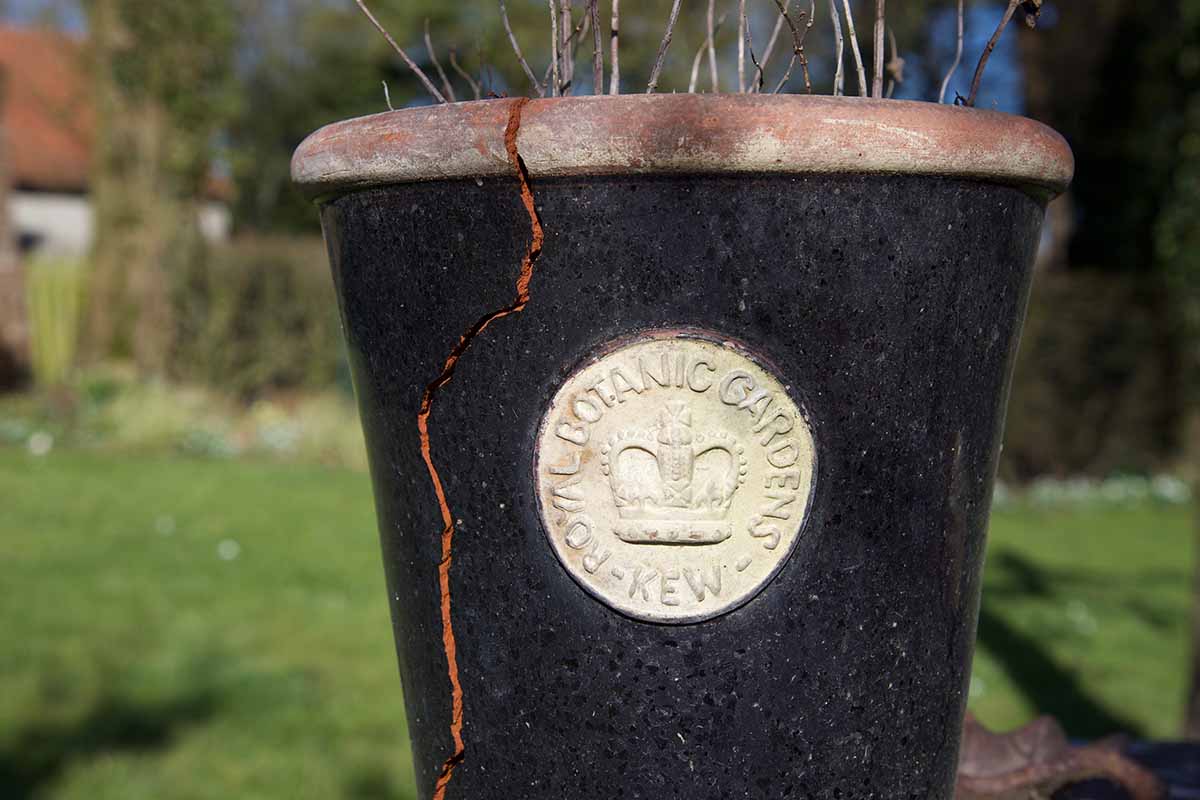
Plastic pots may also deteriorate in prolonged sun exposure, leading to brittleness and cracking.
Saving money on a less expensive pot is nice but having to replace ruined crops cancels out the savings!
No matter which type of planter you choose, make sure that it has drainage holes so excess water can run off.
Cultivars to Choose
There are so many types of lettuce to grow at home that this list is just the tip of the iceberg – pun intended.
Perhaps a better way to approach making a choice here is to start with what you want from yours.
Are you a fan of butterhead types, with their thinner, softer leaves?
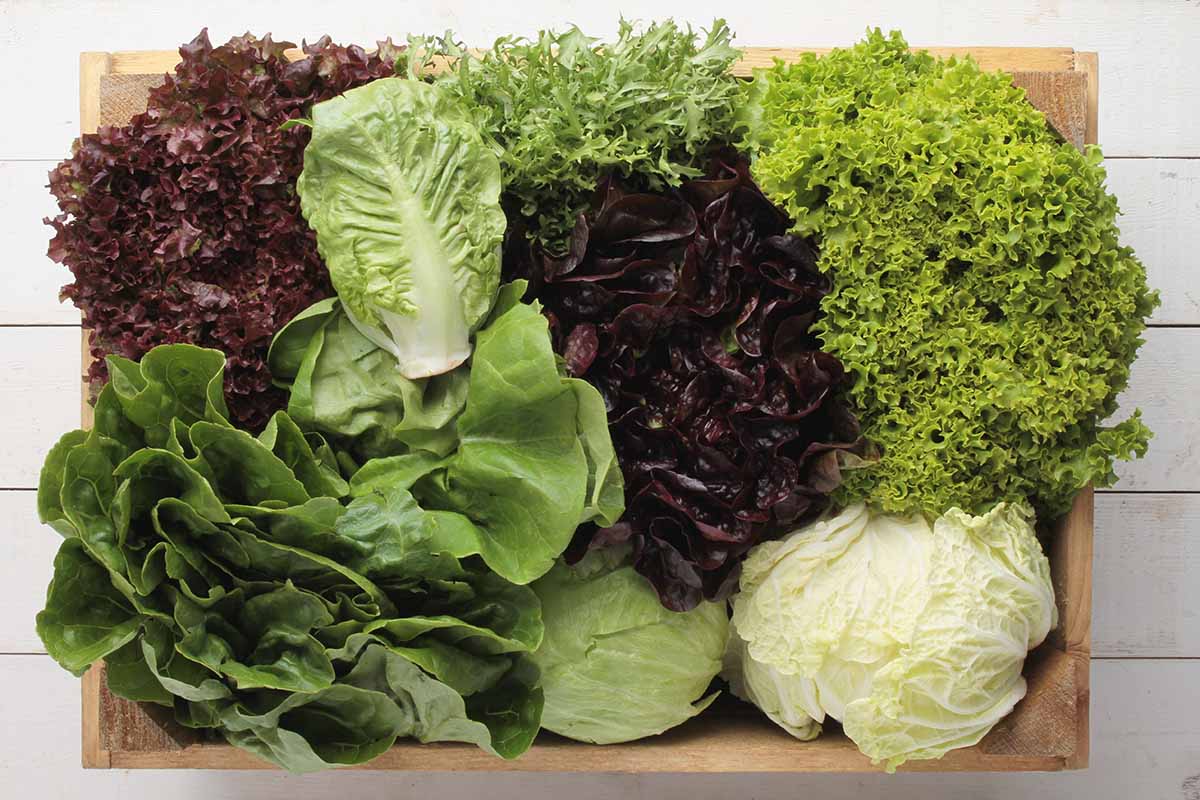
Or would you rather have crisp, crunchy leaves like romaine or iceberg to combine with other veggies and your favorite condiments to make salads?
What about loose leaf types that can be harvested throughout the season?
Deciding what you’re most eager to eat first may help to narrow down the best possible types for you.
Once you have an idea of the type you’d prefer to plant, here are a few popular varieties that grow well in containers for you to consider.
Buttercrunch
Butterhead, aka Bibb, lettuce is velvety soft, with thin leaves that are pliable and fold well into wraps and sandwiches.
These types can be harvested as a head or as individual, cut-and-come-again outer leaves over the course of a season.
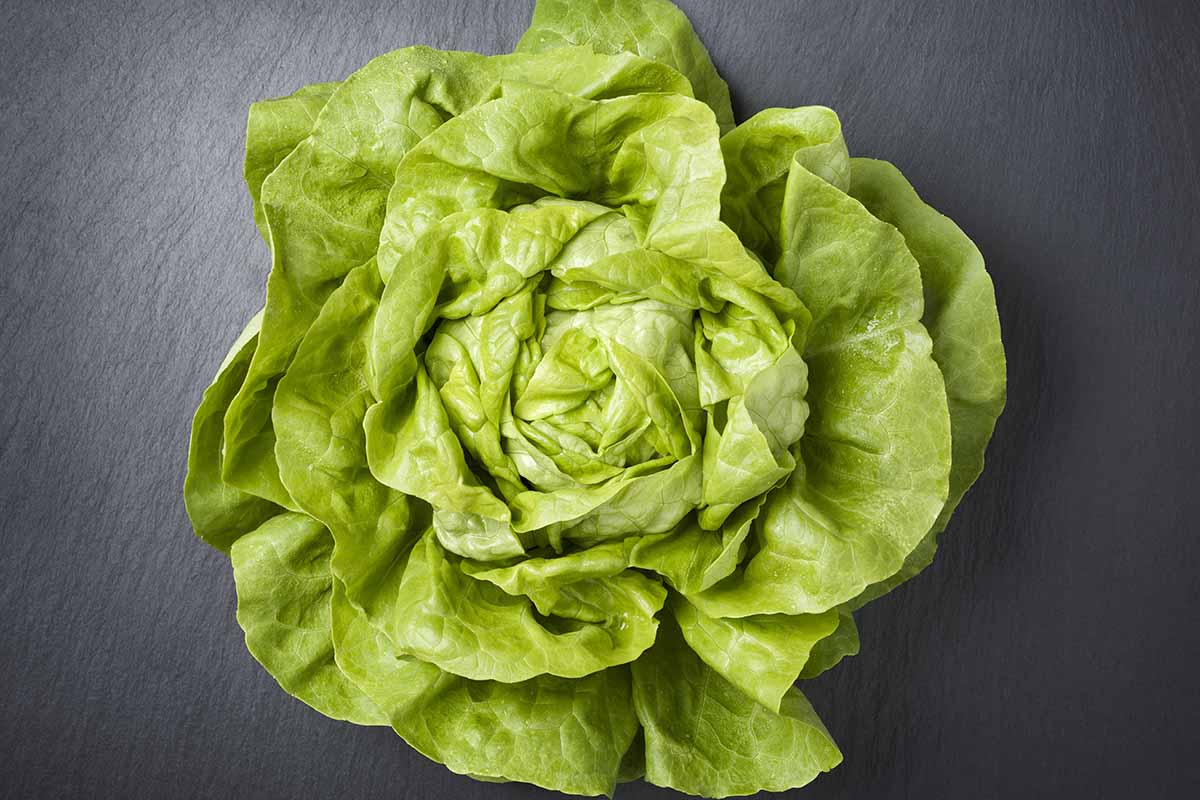
‘Buttercrunch’ is an heirloom cultivar that was bred in the 1960s by George J. Raleigh at Cornell University.
Its large leaves create beautiful emerald-green whorls of foliage, five to seven inches wide and three to five inches in height.
They look lovely and grow relatively fast at 60 to 70 days to maturity. Read about ‘Buttercrunch’ care in our complete guide.
This cultivar makes an excellent choice for container growing thanks to its easy to maintain “cut-and-come-again” leaves, and a relatively compact size.
In fact, it’s one of the most common types chosen for hydroponics and towers.
Since ‘Buttercrunch’ is more heat tolerant than some varieties, it’s less likely to bolt in temperatures up to about 80°F.
Maybe that’s one of the many reasons that it’s an All-America Selections Winner.
You can purchase a one-gram packet of ‘Buttercrunch’ seed from Botanical Interests.
Forellenschluss
The name may be a mouthful, but that hasn’t stopped ‘Forellenschluss’ lettuce from becoming a popular heirloom variety over the last century.
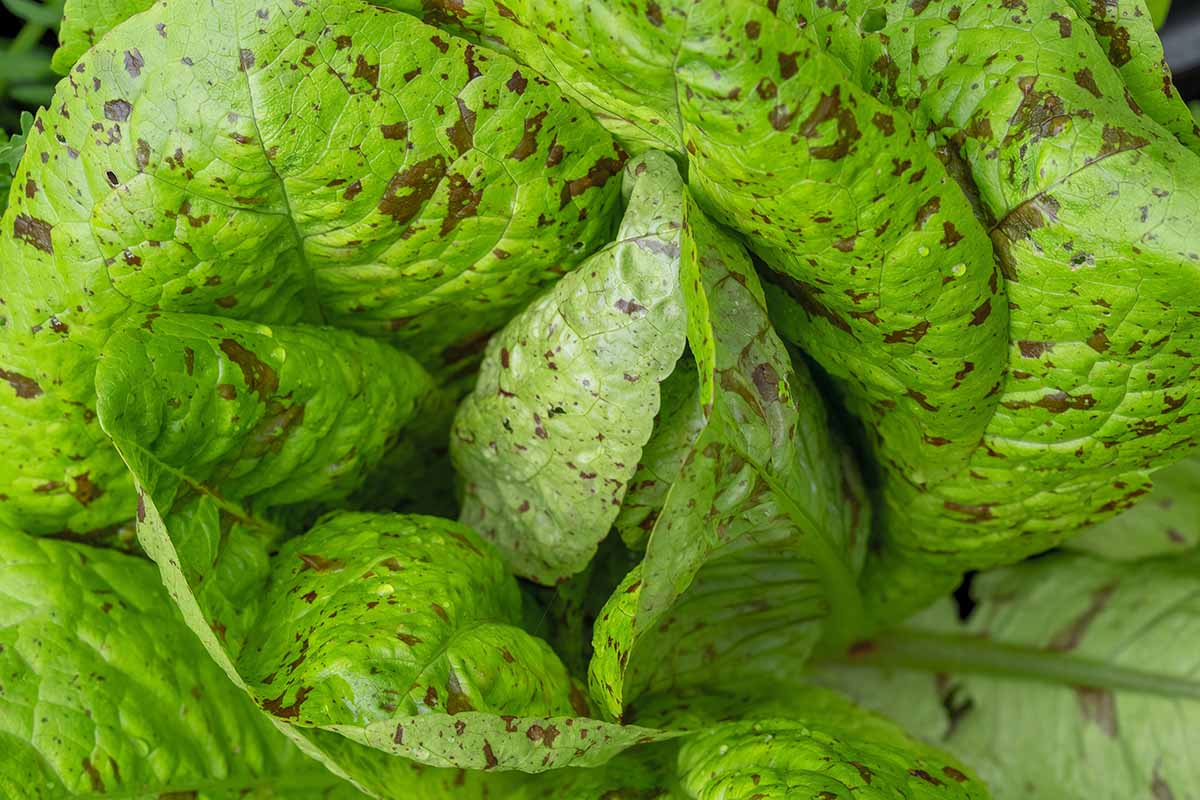
This German type has a sweet, grassy flavor and produces large, eight- to 12-inch heads of speckled, red and green leaves. In fact, the name translates to “like a trout’s back” in English, denoting the speckles.
‘Forellenschluss’ adds color and texture to a container and pairs well with leaf types to make a blend that can be harvested together as mesclun for a more complex flavor profile.
Its leaves are crisp, sometimes compared to romaine in texture.
What makes this type great for containers is its baby leaf potential. It can be harvested early, prior to full maturity, as small, tender, crisp leaves with a mild but bright flavor, which can save some space throughout the season.
Space seeds 10 to 12 inches apart and give this variety, which is sometimes called ‘Freckles’ in English, 70 to 80 days to reach maturity in a container that receives full to partial sunlight with temperatures in the 40 to 75°F range.
Find packets of 500 ‘Forellenschluss’ seeds available from Burpee.
Webb’s Wonderful
If you’re a fan of crisphead varieties, also known as iceberg, then you may want to pick ‘Webb’s Wonderful’ to grow in your home container garden.
This English heirloom was bred by Clarence Webb in the late 1800s.
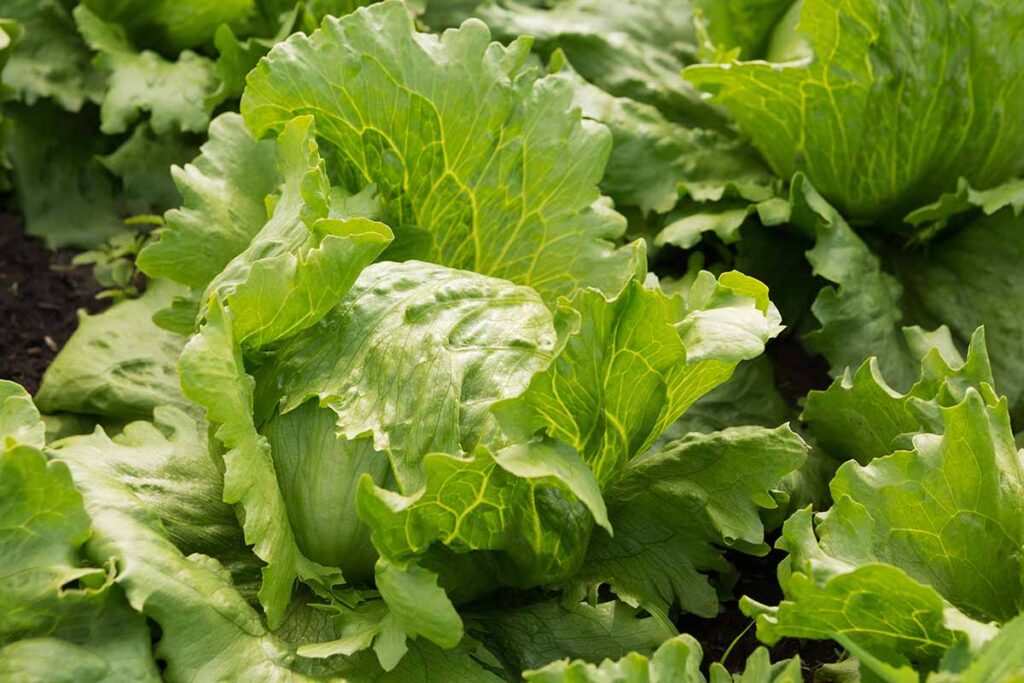
This variety forms large, tight, crisp heads, sometimes over 11 inches in diameter, that tolerate heat very well.
While primarily considered a heat-tolerant, slow-to-bolt type, powering through high temperatures over 80°F without wilting, it also withstands lows in the upper 30s.
‘Webb’s Wonderful’ is a good choice for potting because it produces larger heads than some iceberg types, meaning you’ll get a lot of lettuce out of just one or two plants.
Allow 70 to 75 days to maturity before harvesting the pale green heads, which have a mild, slightly sweet flavor and juicy crunch.
Packages of ‘Webb’s Wonderful’ seed are available in one-ounce to one-pound sizes from True Leaf Market.
Suddenly, I’m craving salad – maybe I’ll whip one up for lunch! But first, let’s go over the ins and outs of sowing seed and caring for your plants.
Propagation
Preparing a potted garden requires a bit of consideration, just like a conventional, in-ground garden would.
I’ll cover some helpful tips specific to container growing below, but we also cover full details on the planting process in our complete guide to growing your own lettuce.
Timing
Late winter or early spring are the best times to start seeds if the seedlings will later be transplanted into outdoor containers.
But it’s much easier to sow directly in the permanent vessel if you can. And plants that will remain inside year-round can be started at any time.
It can take two to three months for most varieties to reach maturity, and sowing seed should be timed to avoid the heat of the summer.

This is important since high temperatures typically signal bolting, which is the process of blooming and producing seed prematurely.
Bolting makes the leaves less palatable, with a bitter flavor and more fibrous texture. However, the plants are not necessarily entirely wasted, even though you may not want to eat them.
Seeds produced after pollination can number in the hundreds, saving gardeners money by eliminating the need to buy more. Those blooms also feed the bees and other pollinators.
Many types of lettuce can be grown even in cold temperatures, frost, and snow, with some added protection, but be sure to plan for that if you’re going to attempt it.
In our guide to protecting lettuce from frost, we’ve got some excellent tips for protecting your crop from chilly weather.
Just keep in mind that container growing reduces resistance to cold and freezing because plants’ roots lack the insulation that would otherwise be provided by soil in the ground.
Heads or leaves may be harvested nearly year-round with the use of staggered sowing. Learn how to plan for this in our comprehensive guide to succession planting.
Placement
Choose a location indoors that will provide temperatures between 60 and 70°F to start your seeds.
Rather than having to harden them off, or gradually move them outdoors once they’ve sprouted, you may be able to start them directly outdoors in their permanent location to save some trouble.
Keep in mind that some regions that experience high heat in the summer may not be suitable for starting outdoors.
In zones where temperatures don’t achieve about 65°F until late spring, starting indoors is best.
If temperature fluctuations are a concern when starting indoors, consistent warmth can be provided from below instead with a heat mat.

Vivosun Heat Mat and Digital Thermostat Combo
I like this set from Vivosun that comes with a mat, a thermostat, and a storage case. It’s available from Amazon.
The ideal seed starting location, whether indoors or out, should receive six to eight hours of sunlight per day, although harsh, direct light coupled with heat should be avoided.
Indoors, your potted lettuce should be placed near a sunny window or provided with a grow light.

I have this one, which I bought from Amazon. It’s great because it clips to a tabletop and can be positioned to shed light over a wide area.
Soil
Loamy, friable soil is best.
If the potting soil you plan to use feels dense and spongy, and forms a ball when it’s moistened and squeezed in the hand, mix one-part coarse sand into two parts soil to improve aeration and drainage.
Shredded bark or leaves can also be used to add additional organic material that will decompose.
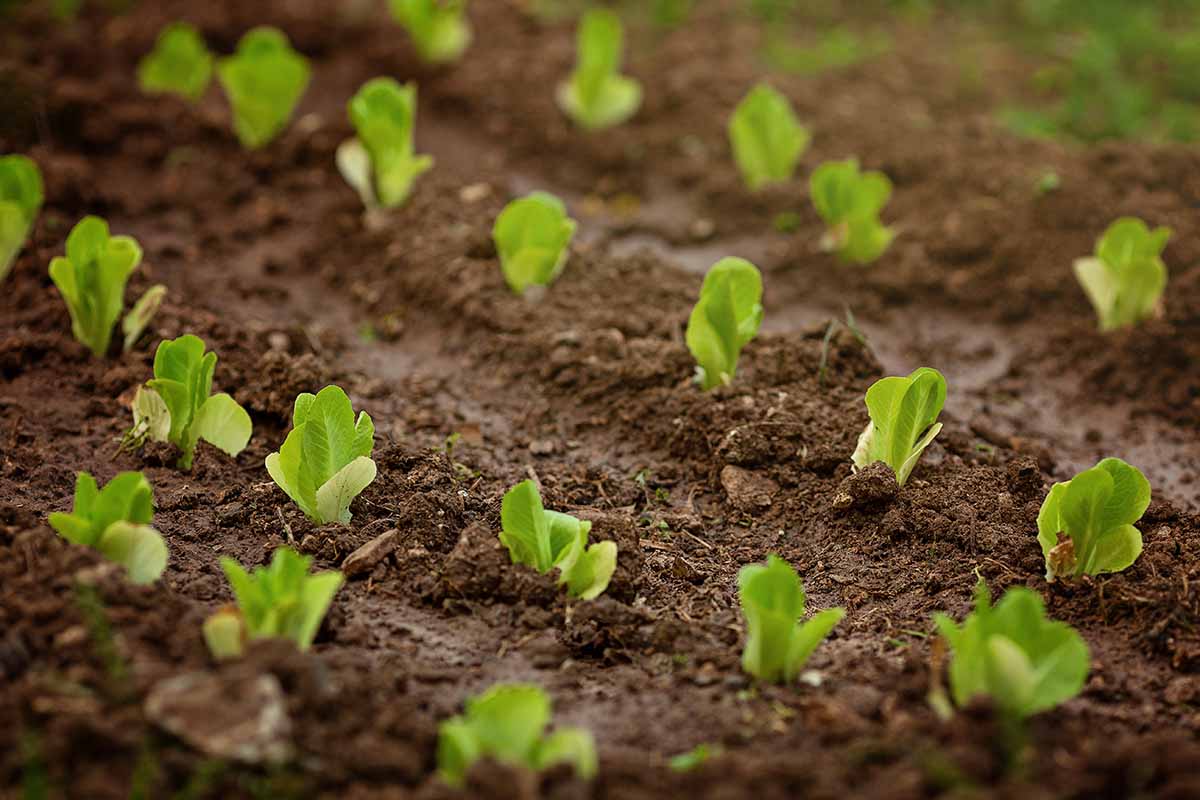
Top dressing with compost after the first true leaves sprout provides a boost of available nutrients to give your lettuce a strong start. Just don’t pile compost against the tender stems.
Soil in containers should be replaced after one to two growing seasons, or any time diseases or pests have been a problem.
Be sure to disinfect your container before you sow new seed if plants have suffered issues.
Water
Consistent watering is important, but keep a watchful eye out for telltale signs of damping off.
Delicate lettuce sprouts are very prone to this illness which can present as wilted, weak, or fallen stems, and often comes with fungus gnats buzzing about.
These shallow-rooted plants don’t handle drought well, so check in every three to five days, or daily during the warmer months if you’re starting seeds for a fall crop.
If the soil feels dry just below the surface, water well and allow excess to drain.
Sowing Seeds
Lettuce seeds are tiny and should be handled with care.
They can also carry disease both inside and outside the seed coat, so soaking the seeds in a warm water and bleach solution can be done prior to planting, if desired.
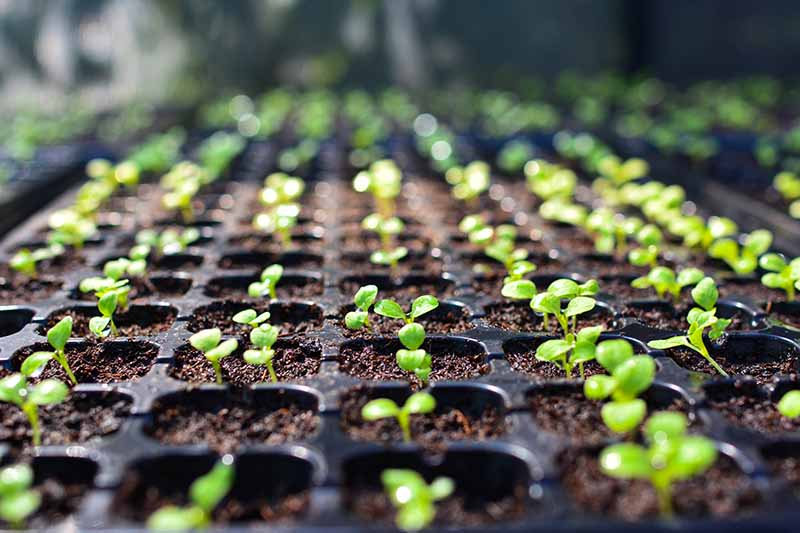
Use the mature size of your chosen variety as a guide for spacing.
Most loose leaf types will need to be spaced six to eight inches apart, but heads may need as much as 12 inches of space between each, or they may require planting individually in containers.
Fill your container or a seed-starting tray to the brim with soil and compact it gently. Water it thoroughly and allow any excess to drain off.
A cell tray with a lid such as this type, available in a pack of five from Walmart, is a good choice to begin if you will be transplanting your seedlings into their permanent pots at a later date.
Seed Starter Trays with Humidity Cover
Press the seeds only about a quarter-inch deep and lightly cover them with soil.
If you’re starting in the winter or early spring, it’s wise to use the cover, which will help them sprout faster. Be sure to vent humidity on warm days.
If possible, sow seeds directly in the vessel in which they’ll remain until harvest. If not, wait to transplant them until they have two to four true leaves.
Transplanting
After seedlings have grown two to three sets of true leaves, they can be transplanted if you’ve started them indoors or in flats.
Hardening off is necessary before moving tender seedlings outdoors.
Start by moving them outside into the shade for an hour or two, and gradually increase the time spent outdoors and their exposure to sunlight each day over the course of about a week.
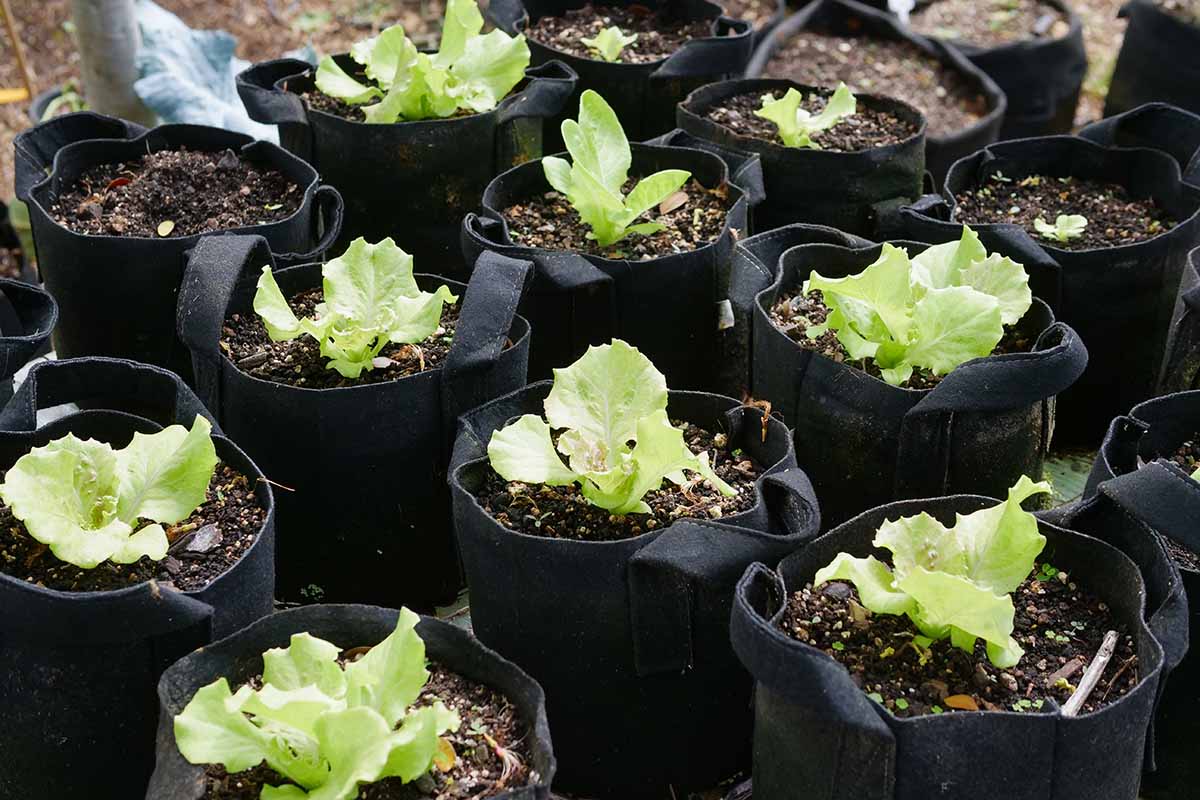
Once they’re acclimated to the outdoors, make a hole in the soil in your container the same size as the root section or plug. Turn the seedling carefully out of its cell or pot, place it in the hole, and backfill around it with soil.
Don’t mound soil around the stem. Press gently with your hands to seat it in place and water it in well.
Place the container in a suitable location and keep an eye out for any signs of wilting – visible cues such as this tip you off that more time in the shade is needed.
Let’s talk about caretaking beyond the seedling stage next!
Caretaking Tips
Once the seedlings are in their permanent home, keep an eye out for signs of pest damage or disease. This may appear as discoloration, stunting, moldy or rotten spots, or die-off.
Companion planting lettuce with rosemary, basil, mint, marigolds, nasturtiums, and other pungent herbs will deter many pests naturally, either grown in the same planter or potted nearby.

Any damaged, dead, or dying material should be cut away with a clean, sharp garden knife or pruners and discarded in the trash to avoid disease spread.
Parts that are dragging against the soil should be removed too, although they can simply be eaten if they appear healthy.
On days when the sun is scorching overhead or temperatures rise or fall into unsafe ranges, move the planter to a location where protection is available if possible.
A shady porch or warmer garage can be a lifesaver.
Feeding
Short-season crops don’t generally require fertilizing other than an occasional top dressing of compost, as I mentioned.
But if you plan to grow more lettuce in succession, it’s best to add more nutrients to replenish the soil.
This could be a synthetic commercial product, compost, or other types of natural fertilizers, added to the soil before sowing more seeds or transplanting new starts.

Learn about the fertilizer options available and how to apply them in our guide, but bear in mind that specimens growing in planters need less overall than crops grown in the ground.
It’s best to dilute liquid fertilizers to 50 percent strength in most cases, or provide about half as much in the case of granular products.
Package instructions will often include tips for use on container plants as well.
Harvesting
When harvesting individual leaves, be sure to select outer leaves to allow the interior ones to continue growing.
Use clean tools and cut near the stem to avoid leaving any dying material intact or in the planter.
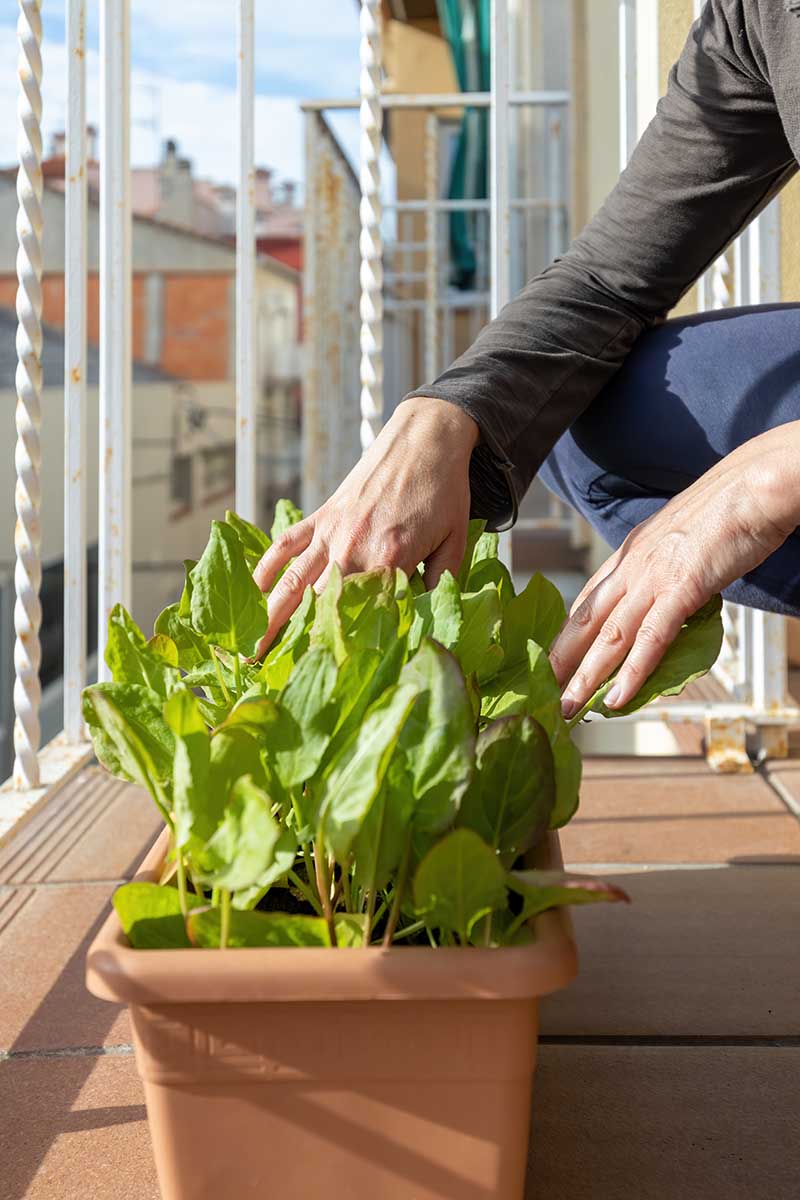
Heads can be dug up by the roots and pulled from the soil, or sliced flush with the soil line with a clean knife to avoid disturbing other plantings.
See our guide for complete details on how and when to harvest lettuce.
After harvesting, healthy soil that has not been contaminated or infested with pathogens or pests can be replanted for up to about two years, as noted above.
Or, you may wish to plant different crops in your container with the changing seasons.
Leafy Lettuce Lends Itself Well to a Potted Paradise
There’s nothing like a fresh salad made with lettuce that you grew yourself, is there?
It just tastes better, and there’s no doubt about where it came from or what it was exposed to while it grew.
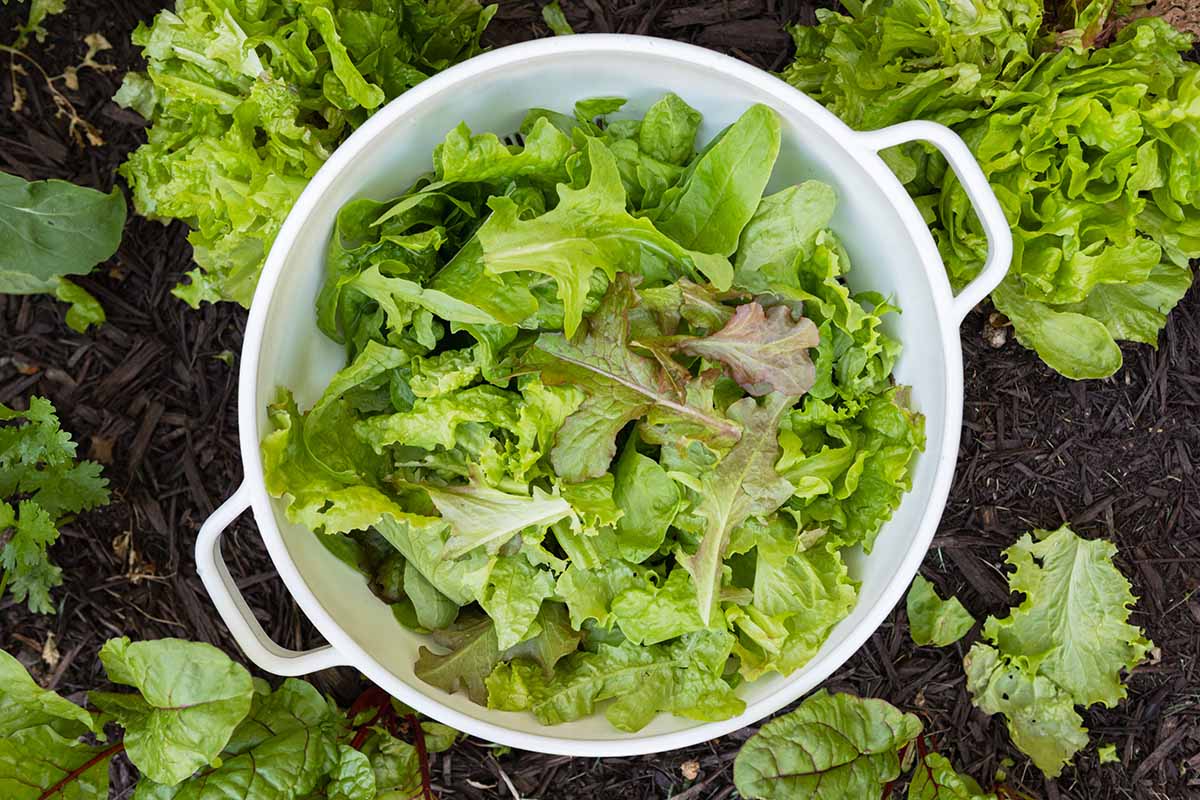
If you have limitations, then that seemingly unattainable garden you’ve been dreaming of might not be so impossible to acquire after all, with the use of containers.
Even budget constraints can be overcome with a bit of creative upcycling – and you can find more ideas in our guide to the best containers to choose for lettuce.
What type of lettuce will you be planting this time around? We’d love to hear all about it, and if you have questions we’re here for you as well. Let us know in the comments below!
And for more lettuce-growing know-how, take a look at these guides next:
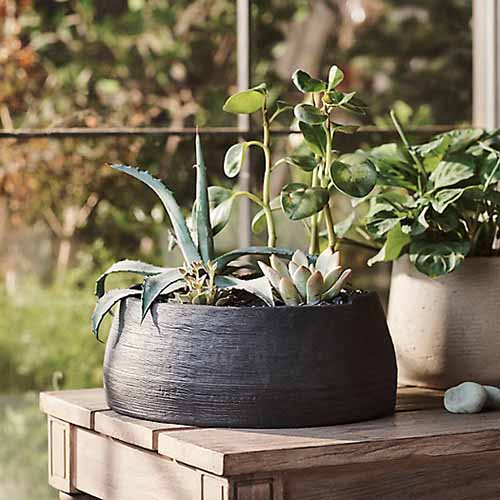
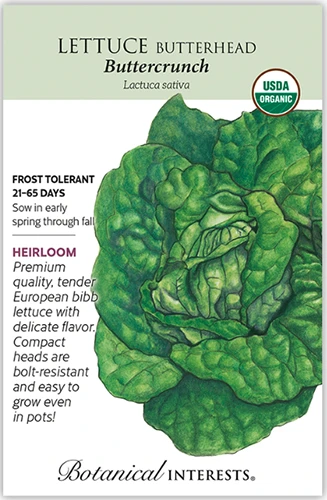
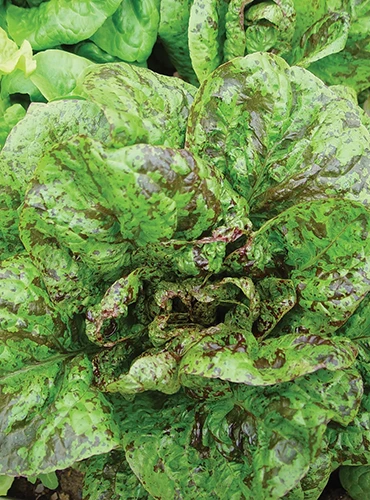

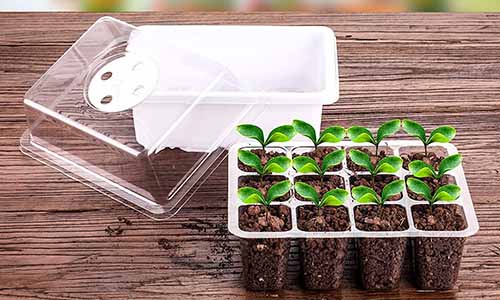
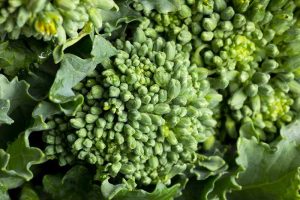

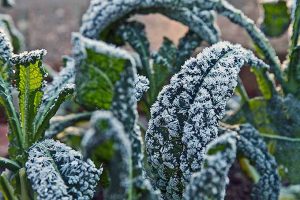
How long does it take for lettuce to germinate?
Good question, Wayne. It depends on the variety and conditions, but you can typically expect germination within 7 to 10 days. See our general guide to growing leaf lettuce for additional information.